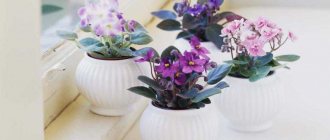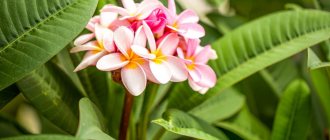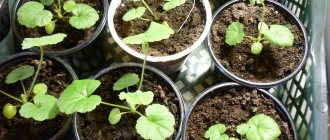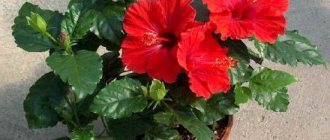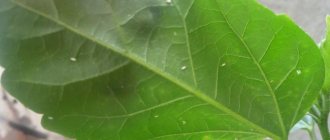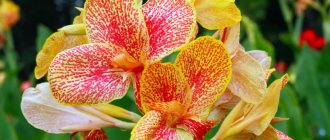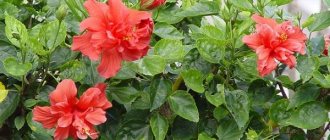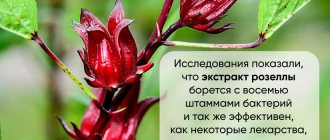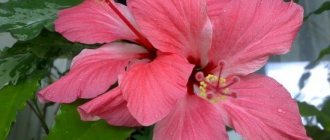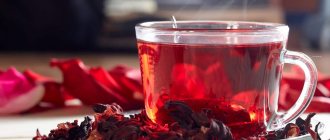Hibiscus is an unpretentious indoor plant. It will delight with its color from early spring until autumn. It is readily grown for room decoration and when creating a winter garden.
But few people know that the hibiscus plant can be not only beautiful, but also useful. Some of its healing properties are written on the tea packaging. These are not all the possibilities of using the plant.
By growing Hibiscus on your windowsill, you will get a beautiful plant and a green home medicine cabinet. The plant's homeland is the tropics, the islands of the Caribbean archipelago, some areas of Eurasia and Africa. There are about 300 species of this plant in total, but not all can be grown at home.
Some types of Hibiscus are used as a food additive in salads and side dishes. Its dried shoots can be found in fruit teas. Basically, it is added to teas such as Hibiscus, Sudanese Rose, Malvacea Tea and other preparations.
Homemade Hibiscus varieties photo
Hibiscus species can be roughly divided according to the requirements for their cultivation into two types: those not suitable for indoor growing and house plants. The last type of Hibiscus has up to 10 varieties, which are not only beautiful, but also useful. Basically only 2 varieties are grown. They are easy to grow on a windowsill. What varieties of homemade Hibiscus are there, see below:
Chinese hibiscus
This type of plant can reach a height of up to 5 meters. If Hibiscus grows in natural conditions. At home, the flower is periodically pruned. It stops growing in height and turns into a beautiful bush. Hibiscus blooms from early spring to late autumn.
The plant has an interesting feature: its flowers last only 2 days, then fall off. New buds appear in their place. Chinese hibiscus is divided into several species, which differ only in the shade and size of the flowers. Caring for Chinese Hibiscus is quite simple. This plant is popularly called “Chinese rose”.
Types of Chinese Hibiscus:
Hibiscus Sanremo
It has dark green leaves and pale white flowers. With proper care, it can bloom from 3 to 5 days;
Hibiscus Tivoli
This type of plant blooms for only 4 days. It has orange-pink flowers. A distinctive feature of this species is the yellow border around the flowers;
Hibiscus Borias
The plant has large lemon-white flowers. The edges of the flowers are corrugated. The flower looks interesting in the living room;
Hibiscus Torino
The flowers of this plant are small in size. The color of the flowers is orange;
Hibiscus Porto
This variety of plant blooms with red flowers. A distinctive feature of the variety is that the flowers are not double, like other types of Hibiscus;
Hibiscus Kyoto Yellow
This hibiscus flower has a yellow flower with a red center.
Chinese Hibiscus varieties, photos illustrate the beauty of each of them. Which type to choose for home cultivation is up to you.
Pruning in spring or autumn
Pruning is a necessary procedure for a flower. In order to properly prune hibiscus, you need to pay enough attention when choosing a tool. Secateurs and a sharp knife are suitable for this purpose. Before starting work, tools must be disinfected.
The pruning procedure is divided into the following types:
- Pruning in spring stimulates the growth of young branches on which new flowers will appear. It is worth pruning 1/3 of last year's branch.
- Hygienic pruning is carried out if the bush has dense branches. Get rid of weak, dried out and diseased shoots.
- The adjustment gives the bush a neat shape. The standard method involves shortening the branches to the level of three buds. Carried out immediately after landing. The peculiarity of this method is that it makes hibiscus decorative.
- Radical pruning. This method is used if the plant is in danger of dying from infection and insect pests. In this case, almost all branches are cut off. If you provide the right conditions for care, you can ensure that the flower comes to life.
- Autumn pruning is done after all the flowers have faded, at the end of September. It is not recommended to carry out the procedure before the onset of cold weather, otherwise the flower will not bloom in the spring. Also, cutting in the fall prepares the plant for wintering.
Advice! Young plants can be pinched. Basically, only the top is cut off, after which the flower will amaze those around with lush blooms in the spring.
Garden hibiscus is a beautiful flower that will be a wonderful decoration in the garden and at your dacha. The plant is healthy and contains a huge amount of vitamins and minerals. The famous hibiscus tea from its petals regulates blood pressure and strengthens blood vessels. Indoor hibiscus purifies the air. With proper care, it will delight its owners with bright colors for a long time.
Syrian hibiscus photo
This flower blooms almost all year round. It has evergreen leaves and flowers of different shades. It can be grown indoors or in the garden. One flower has a diameter of 7 to 12 centimeters. In appearance, Hibiscus flowers resemble mallows. The flower lives only one day.
Syrian Hibiscus can be of several varieties:
Hibiscus Totus Albus
It has snow-white flowers;
Hibiscus Monstrosus
Blooms white flowers all spring and autumn;
Hibiscus William R. Smith
This variety has white flowers with a red center;
Hibiscus Woodbridge
Blooms red with a ruby tint;
Hibiscus Blue Bird
It has blue or purple flowers. The flower may also be blue-violet;
Hibiscus Speciosus
It has double flowers, the shade of each flower is white, and its middle is dark red;
Hibiscus Jeanne d'Arc
Blooms with yellow-white flowers;
Hibiscus Due de Brabant
It has double flowers of a dark red color, they may have white stripes;
Hibiscus Ardens
It has pink and purple flowers.
When choosing a type of Syrian hibiscus, consider your region. Plants with double flowers love warm and mild climates. Such a flower cannot be placed on the balcony in early spring. He will die from low temperature.
Saplings
Garden hibiscus is propagated by bending the lower shoot to the ground in the spring, covering it with earth and securing it. The soil needs to be moistened for a month until roots appear. Rooted seedlings can be replanted in the fall or spring of next year.
With sufficient heat and light, the seedlings begin to grow actively and bloom by the end of summer. Hibiscus requires pruning to encourage growth and flowering.
When choosing a propagation method, you should remember that cuttings are considered optimal. Plants obtained from seeds will not soon please you with flowering.
Hibiscus how to grow full-fledged plants from seeds
The plant reproduces well by seeds. Growing it from seeds is easier than propagating it from cuttings. Cuttings do not always take root and require more attention than seeds. How to grow hibiscus from seeds?
Choose the desired plant variety. You can buy it in “Everything for the Dacha” stores, from grandmothers at the market or at a flower stall. It is convenient to grow plants in a wooden box. You select its size based on the required number of young animals.
A universal mixture for indoor plants is suitable as soil. They pour it into a box and level it. Water the soil thoroughly before sowing the seeds. Seeds are sown in a previously prepared furrow. According to the sowing principle, the process resembles planting carrots in a garden bed.
Seeds should not be deeply covered with soil. Otherwise, the sprouts may not break through the soil cover.
Cover the box with seeds with film or glass and place in a warm place. But don’t forget that it needs to be ventilated regularly. Ideally 1-2 times a day. watering an indoor greenhouse using a plant sprayer, but not from a cup. It's better for the plants.
As soon as the sprouts emerge from the ground, the glass is removed from the box. Now the plants need fresh air. Individual plants that are faster than others in growth are planted in small pots or glasses. Thus, from one box you can get up to 50 new plants. Considering that Hibiscus is easy to care for, it can be successfully sold.
Graft
For vaccination to be successful, you must consider:
- use a young Chinese rose plant to graft cuttings;
- grafted into the crown of the plant;
- there should be no more than 5 grafts in the bush;
- Vaccination is recommended at the beginning of the summer months.
Grafted plants must be cared for, provided with a well-lit place and regular feeding.
In winter, grafted hibiscus requires additional lighting (about 6 hours a day) so that the vaccination does not die.
The use of grafting allows you to obtain several varieties on one plant.
Hibiscus propagation at home by cuttings
Hibiscus can also be propagated by cuttings. If you don't want to wait for the seeds to grow into plants, you can use cuttings. The optimal time for plant propagation is June. Cuttings up to 15 centimeters in length are cut from the plant. They are cleared of leaves and soaked in a special solution to stimulate growth.
The cuttings should lie in this substance for 18 hours. Then a mixture of sand and peat is prepared. It is poured into small pots and cuttings are planted there (1 piece per pot). The planting depth of the plant should not exceed 3 centimeters.
Then a specific frame is prepared from wire and polyethylene. A pot with a cutting is placed under this dome for 3 weeks. The dome provides high humidity inside itself. This promotes root formation.
The temperature in the room where new plants are grown should be no less than 25 degrees. If it is smaller, the cutting will not take root. Plants should be planted in standard-sized pots 3-3.5 weeks after they have taken root. Select a room where there are no drafts. Young plants do not like dry soil. Watering should be regular. But stagnation of water will not bring any benefit.
If you need to grow Hibiscus, propagation at home from cuttings will be the best solution.
Solving possible problems
In the process of growing Chinese roses, the following difficulties may arise:
- If the leaf blade turns yellow, this indicates a lack of iron and nitrogen. Watering with settled water with the addition of iron compounds will help solve this problem. When fertilizing does not give the desired result, it is worth inspecting the roots, as they may be damaged by frost or fungus.
- If there are few flowers and a lot of greenery, stop applying nitrogen-containing fertilizers. Also take care of high-quality lighting and a warm climate.
- During dry weather, with inadequate watering, the plant can be affected by spider mites. To prevent this, spray the bush in the morning and evening with water from a spray bottle.
- Sweet nectar attracts aphids to flowers and buds. Here you will have to use special chemicals for processing.
Watch a video about the prevention of hibiscus diseases and preventive pest control measures:
It may seem to some that the seed method of planting hibiscus is a complicated matter, but to others this propagation option will seem the most optimal. But all gardeners certainly agree that the flowering of this bright plant brings joy and at the same time pride in growing this beauty.
Hibiscus how to care for a flower at home
Hibiscus is grown in pots at home. If you care for the flower correctly, it will bloom from early spring until autumn. Hibiscus loves a sunny place. But, protect it from direct rays of the sun. Provide a temperature of 20 to 25 degrees.
During the flowering period, the plant is watered regularly. After each watering, loosen the soil in the pot. Hibiscus does not tolerate drafts. It needs to be sprayed every day. This is true in winter, when the air is dried out by heating devices.
Hibiscus flowers begin to form at temperatures of at least 15 degrees Celsius. Why then does the plant not bloom? Many gardeners face this problem. The bottom line is that a temperature of 15 degrees does not dry out the soil. With regular watering, water stagnates in the pot. Do you want the plant to bloom? Water it less if the apartment is 15 degrees Celsius.
There is Hibiscus, how to care for it at home if almost no one is at home? At the optimal temperature, the plant blooms almost without watering. For example, in offices where it is not so warm and plants are often forgotten to be watered, Hibiscus blooms profusely.
In winter, the plant recovers. Watering should be reduced. You cannot move a flower pot from place to place. During the recovery period, it is better not to disturb Hibiscus. They find the coldest place in the apartment for it and leave it until February.
Sometimes the flower is fed with plant fertilizers. In such soil it grows actively and will delight you with flowers for a long time.
Diseases to which the flower is susceptible
Most often, Hibiscus undergoes chlorosis, that is, yellowing and falling leaves. To avoid this, it is recommended to spray the leaves with an iron chelate solution, which you can prepare yourself. To do this, iron sulfate (4 g) is diluted in 1 liter of water, preferably distilled, then 2.5 g of citric acid is added.
In order for the flowering period to begin earlier, the plant must be fed with special flower fertilizers. However, it should be remembered that if Hibiscus is “overfed” with nitrogen-containing fertilizers, you can get abundant foliage, but there will be very few flowers.
Hibiscus beneficial properties and contraindications
The Hibiscus plant is not an ordinary indoor flower. It can be used for cooking and added to tea. What are the beneficial properties and contraindications of Hibiscus?
Useful properties of hibiscus
Hibiscus flowers are actively used for the treatment and prevention of many diseases. These are mainly gastrointestinal diseases, skin diseases, dysentery and hemorrhoids. Hibiscus leaves contain flavonoids. They remove toxins and harmful substances from the body. Eating the leaves and flowers of the plant can activate the body's metabolism. As a result, this will lead to natural weight loss.
Hibiscus should be added to the diet for the prevention and treatment of worms. Decoctions and tea from Hibiscus kill the larvae and eggs of worms and remove them from the body. Hibiscus is used to stimulate bile production and cleanse the liver of harmful substances. It helps increase metabolism.
Hibiscus flowers are used as a diuretic and choleretic agent. They can be used as a remedy against inflammation and seizures. The flowers of the plant can also be used as a means to stop bleeding.
Hibiscus inflorescences contain citric, malic and ascorbic acid. They can be taken by people with kidney problems. Hibiscus tea can be drunk to prevent the formation of kidney stones. You can drink this tea to strengthen your immune system.
During the winter, you will get less flu and will not catch a viral infection. Decoctions and infusions are drunk as a preventative against colds. Fresh hibiscus flowers can be applied to wounds, abscesses and tumors. When crushed, they can be useful in the treatment of malignant tumors.
Boys and girls can use the plant to treat inflammatory processes on the skin and acne. In the form of lotions, flowers are used to prevent and treat eczema and other skin diseases.
Contraindications to the use of hibiscus
In fact, there are not many of them. Hibiscus should not be consumed by people with high stomach acidity. It is not used by those who have problems with the duodenum or stomach ulcers. It is not advisable for pregnant women and nursing mothers to take decoctions. Children under one year old are also prohibited from consuming Hibiscus.
Hibiscus tea: beneficial properties and how to prepare
Hibiscus flowers can be used to make delicious tea. It is called differently: “Hibiscus”, “Sudanese rose”, “Kandahar”, “Drink of the Pharaohs”. Tea can be prepared at home or purchased at a pharmacy. Tea contains a substance called anthocyanins. They give the drink a red color. Anthocyanins help strengthen blood vessels and normalize the functioning of the circulatory system.
If you drink hot hibiscus tea, its beneficial properties help solve problems with the nervous system. This drink helps cleanse the liver of harmful substances and removes toxins from the body.
You can drink Hibiscus to increase blood pressure. It is consumed hot. When you need to lower your blood pressure, drink tea cold.
You can make hibiscus tea at home. To do this, you need dried flower petals and boiling water. 2 tablespoons of flowers are poured with 2 cups of boiling water. The decoction must be left to steep for 30 minutes before use.
Do not bring the broth to a boil. At very high temperatures, dyes decompose. The drink becomes dirty gray and its beneficial properties are lost.
Growing Hibiscus at home is not so difficult and profitable. You will not only have a beautiful plant that blooms all year round, but also your own pharmacy on the windowsill.
Leave a review and get a plus for your site karma:
